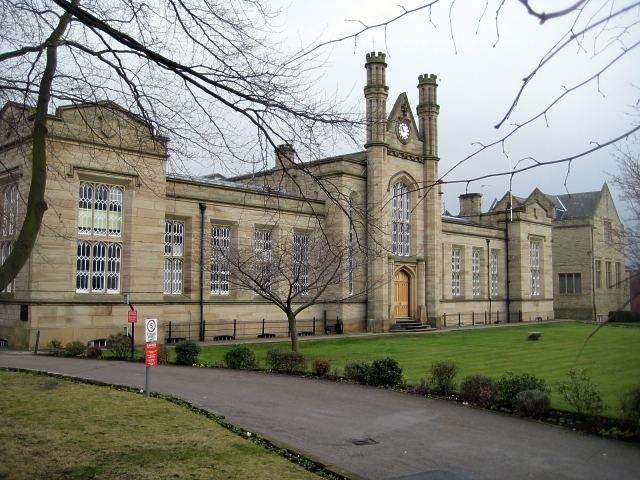Established 1591 Headmaster David Craig Founded 1591 | Religion Church Of England Phone +44 1924 373943 | |
 | ||
Type Independent school Public School Founder Thomas Saville and others Location WakefieldWest YorkshireWF1 3QXEngland Similar Kettlethor High School C, Silcoates School, Wakefield City Academy, Horbury Academy, The Rodillian Academy Profiles | ||
Queen Elizabeth Grammar School (QEGS) is an independent, public school for boys in Wakefield, West Yorkshire, England. The school was founded by Royal Charter of Queen Elizabeth I in 1591 at the request of leading citizens in Wakefield (headed by Thomas Saville and his two sons) 75 in total and some of whom formed the first governing body.
Contents
- Founding
- The Coat of Arms
- School Song
- Facilities
- Sport
- In popular culture
- Academia
- The Arts
- Politics
- Miscellaneous
- Religion
- References
In 1854 QEGS moved to its present site in Northgate, Wakefield, into premises designed by the architect Richard Lane and formerly occupied by the West Riding Proprietary School. The attached Junior school for boys aged 7 to 11 was founded in 1910.
The school is part of a foundation, with both QEGS Senior and Junior schools joined together, along with the nearby Wakefield Girls' High School and its Junior School, and Mulberry House, which is a nursery and pre-prep department.
As of September 2010, the current headmaster of the school is David Craig, taking over Les Hallwood, who stood in as acting Headmaster during the time between the leave of the previous headmaster, Michael Gibbons, and the beginning of the next academic year.
QEGS is a member of the Headmasters' and Headmistresses' Conference.
Some notable former pupils include, John Wolfenden, Baron Wolfenden, Joseph Moxon, Mathematician and Hydrographer to King Charles II, Richard Henry Lee, signer of the United States Declaration of Independence, US Senator and President of the Continental Congress, Mike Harrison, former captain England national rugby union team, Mike Tindall, England Rugby Union player, member of the World Cup winning team in 2003. John Potter, Archbishop of Canterbury and The Rt Revd and Rt Hon The Lord Hope of Thornes, former Archbishop of York.
Founding
Queen Elizabeth Grammar School dates back to 1591. Mary Queen of Scots was dead and the Spanish Armada had been defeated and, in the following time of relative peace, the leading citizens of Wakefield could think about the future education of their boys with some assurance. On 19 November 1591 the charter was granted to fourteen men to act as Governors of the new school.
The Charter read:
Five of the fourteen men designated to be governors bore the name Saville. Generations of the Saville family have played important roles in the school’s history and hence the reason why the Old Boys’ Association is called The Old Savilians’ Club
The school prospered and grew in numbers and in 1854 moved from the original school building to its present site in Northgate. The availability of bequests and grants enabled the school to attract pupils from a wide catchment area and a broad range of social backgrounds. This trend continues today through Foundation Awards, Scholarships and Bursaries.
The Coat of Arms
The School Arms came into existence soon after the school was founded and features a lion, an owl and a bible. The golden lion on a red field refers to the royal foundation; the silver owl on black is taken from the arms of the Savile family (one of the founding families) and the Bible indicates the religious side of education. The school motto – Turpe Nescire – means “It is a disgrace to be ignorant”.
School Song
Around 1900, H.G.Abel, then the Senior Classics Master, composed 'Floreas, Wakefieldia' and Matthew Peacock, Headmaster and Honorary Choirmaster at the Cathedral, set the words to music. It was seen as fitting that the song should be written in Latin, thereby evoking echoes of traditional scholasticism. The song is still sung today – at Founders' Day, Speech Day and at all Old Savilian Club Dinners.
Facilities
A new building (the Saville Building) was opened in 2005 by Ted Wragg, the famous educationalist, who taught at the school in the early 1960s. The new building provides a new 6th Form Centre, English Department, state-of-the-art Theatre, and Learning Resources Centre for the pupils of QEGS.
Sport
The school is often noted for its sporting ability, having achieved frequent success in a number of sports. Over 83% of the school's boys represent QEGS in one sporting event or another. The most popular sport is Rugby Union, followed by Hockey, Cricket, Athletics and Basketball. Hockey in particular has experienced substantial growth in the school throughout the last decade, and is now close to matching Rugby Union's dominance internally. In 2006, 2013, 2014 and 2015 the under-15's Rugby side reached the Daily Mail Cup final. winning the competition in a tight 15-6 win over three tim rivals Warwick. In 2009 every age group won the hockey 'Yorkshire Cup' for the first time in the school's history with the under 16's going on to reach the national semi-finals, only to lose to Whitgift School. As well as plenty of sporting opportunities, the School also gives students the opportunity to participate in the Duke of Edinburgh's Award Scheme. The picture shown is the Sixth Form Centre for sixth formers.
In popular culture
Academia
The Arts
Music
Literature
Art
Film
